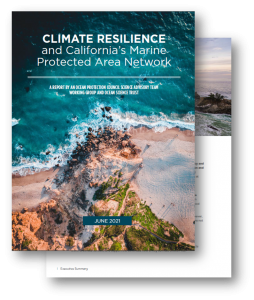“Science is essential not just for detecting threats, but for testing solutions. Both matter, but focusing on the former leads to pessimism, while the latter fosters hope and moves us forward.”
I read this quote recently by research ecologist Kerstin Wasson, and it struck me how perfectly it encompassed my past year and a half – convening an expert working group for California at the beginning of the pandemic (and let’s not forget also the acts of racial injustice and the major California wildfire season that hit way too close to home). Our charge at hand while sheltering in place: to search for resilience in a time where it felt nowhere to be found.

Read the Full Report: Climate Resilience and California’s Marine Protected Area Network: A Report by an Ocean Protection Council Science Advisory Team Working Group and Ocean Science Trust (June 2021)
In preparation for the first adaptive management review of California’s marine protected area (MPA) network, I led an expert working group to explore the role of the state’s MPA network in imparting climate resilience. To kick it off, on February 27, 2020 (pre shelter-in-place) we convened leading ocean climate scientists, ecologists, and MPA researchers in Sacramento together with leadership from California’s MPA management team at the Ocean Protection Council and Department of Fish and WIldlife. This would be one of our last in-person gatherings of the year.
During the height of 2020, focusing on a longer-term climate change effort felt dwarfed by the need to tend to immediate concerns for one’s own health and safety. But then I’d quickly remind myself that these events are exactly why we need to plan for long-term resilience. More and more we are going to be faced with converging stressors and extreme events like those of 2020. Now more than ever we are seeing the direct impact of increasing human pressure on the natural environment – manifesting itself in new (and predictable) ways and with significant ecological and social consequences. Some of the most severe climate events on record are happening with increased frequency and intensity across the California Current Ecosystem, including marine heatwaves, low oxygen and pH conditions, and rising seas.
We need to act now to deploy all of the management and policy tools at our disposal to fight climate change – including our MPA network. A decade ago, climate change was absent from MPA planning efforts. However, California’s investments in the implementation of the Marine Life Protection Act, which established an ecologically connected network of 124 MPAs, provides an invaluable foundation to support ecosystem resilience and protect biodiversity in the face of climate change. In our report, we document the many ways in which MPAs – regions with reduced or restricted harvest, disturbance and other human activity – may also offer resilience to climate change, and recommend actions to elevate MPA within the state’s climate resilience toolbox.
And while these efforts can feel like small steps given the daunting challenges ahead, the pandemic showed me just how resilient we can be, and reminded me to celebrate all our accomplishments and progress toward a climate-ready future.




